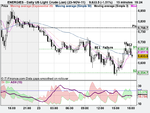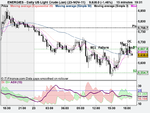Do you not like that book? I read it a while ago when I first started trading and I must admit - It taught me the basics I needed to know.
If I'm being charitable, I think that Mr Nison is being fooled by randomness. Its quite interesting that even in his hand picked examples for the book, there are charts that show numerous failed examples of patterns covered elsewhere in the book.
Not surprisingly, there's quite a bit of academic research undertaken into candle patterns (its easy to do, as the patterns easily measured and identified). Nison has been openly critisised by a number of authors, and has to date been totally unable to refute that critisim other than to reply with platitudes regarding "applying the patterns in context", or "applying with discretion". Most of these academic studies completely ignore the bleedin obvious, and conclude that just because a particular entry signal isnt profitable, it doesnt work (ignoring the other 99% of factors that differentiate profitable from non profitable trades), however, they are right to point out that simple patterns are statistically non valid.
Of course particular patterns will occur at turning points, its a moments work to scan back through a chart and find a doji, or engulfing patern at a turning point, but that in itself is pretty meaningless. Its equally easy to find examples of patterns where long shadows identify area'a that later act as support or resistance. The problem is, exactly the same features apply on randomly generated time series, with equal statistical significance.
I'm not saying that candle patterns are not a reasonable entry trigger (and I have used them, and maybe even will again in the future), but the reality is, over a large enough sample size, they are no better than a random entry.
You see people combining and blending candles, you see people applying discretion, but thats no different to retrospectively modifying the parameters of an indicator to get into a trade, or to filter out a losing trade.
I'd probably argue that any book that focus's on entry signals isnt ever going to be a particularly great trading book. I accept that the book is a little more than that, but really, some of the nonsense he comes up with is beyond belief.
There's practically a whole chapter arguing why a candles which show open, high, low and close, are SUPERIOR to bars (which show precisely the same information!)
Maybe I'm being a bit unfair on Nison, but the least I'd expect out of any credible author is to back up his or her claims with hard statistics, rather than a few hand picked examples.


